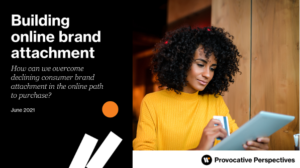 As ecommerce sales increase rapidly, accelerated by the pandemic, retailers are scrambling to get the operational side of their businesses up to scratch.
As ecommerce sales increase rapidly, accelerated by the pandemic, retailers are scrambling to get the operational side of their businesses up to scratch.
But what about the impact of the online sales boom on the backbone of a business, like consumer loyalty? Our new research gives a clear answer to brands in the US and far beyond – consumers are becoming less attached to brands in their online path to purchase. Here’s why – and what to do about it.
Our goal was to get quantified, in-depth insights on how increased buying online has affected people’s attachment to brands. This is pivotal right now to the growth of our clients who are bought more frequently online – and essential to future-proofing their marketing strategy as ecommerce has an ever-increasing impact on attitudes to brands and buying behaviour.
Using Wavemaker’s Momentum methodology and US database, we compared online and offline consumer decision journeys across multiple categories to research the effects and implications.
The lower brand attachment we uncovered is being driven by three factors:
- Online consumers consider more brands than offline in their evoked set (50% more). In general they actually have a higher Brand Bias, but they show this attitude towards many more brands. Instead of leaning towards two sport brands, they consider around three; instead of four yoghurt brands they consider six.
- Their brand bias is based less on emotional values than brand bias for offline buyers, and more on ‘brand icons’ (key products in a portfolio that represent the brand and its strengths, acting as an anchor for recognition) and to a large extent on consumer experience. While emotional aspects still play a role in cementing the brand bias, they are less easy to establish online.
- Across all categories there is stronger reviewing and comparison activity by default. As a result, consumers switch more online (more than anticipated) in the active part of the funnel – even for lower involvement and habitually bought products – reflected in a -8% lower online conversion on average for brands with a strong priming stage bias.
That’s the bad news – a clear, fact-based dilemma for even the most successful online brands to address. The good news is that we’ve found and validated five ways to overcome this declining brand attachment and increase stickiness for online shoppers:
- Brand building in an online environment is even more important. Besides an elevated marcom investment at brand level, stronger online brand bias is established by stronger roles for the master brand, synergizing brand and ecommerce campaigns and using both offline and online media.
- Building brands through hero products or ‘product icons’ that are consistently supported throughout brand communications create stronger online brands, instead of simple brand value messaging (remember our online consumer is constantly reviewing and comparing).
- Consistency in message, visuals and media usage is more important than ever to increase final conversion, in a more scrutinized online path to purchase with 25% more actions and 43% more touchpoints used than offline.
- Preference building in the active stage. While the offline customer decision journey is predominantly focused on conversion, consumers switch more easily during the online journey. Brand preference is also built on active experiences.
- A complete ecommerce ecosystem is growing in importance, with active roles for social commerce (a crucial opportunity to drive impulse buys and engagement) and strong services and content within direct-to-consumer platforms that are strong conversion and loyalty drivers beyond product.
As ecommerce increases its share of sales in many (most) categories and changes the way we consider and buy brands, its impact on loyalty is big and set to get bigger. Unsurprisingly for such a complex space, there are no easy answers or quick fixes, but these five steps are a great start to protecting that precious goodwill towards your brand.
If you’d like to see the full research deck, please email [email protected], thank you
 Dennis Potgraven, US Chief Strategy Officer
Dennis Potgraven, US Chief Strategy Officer





